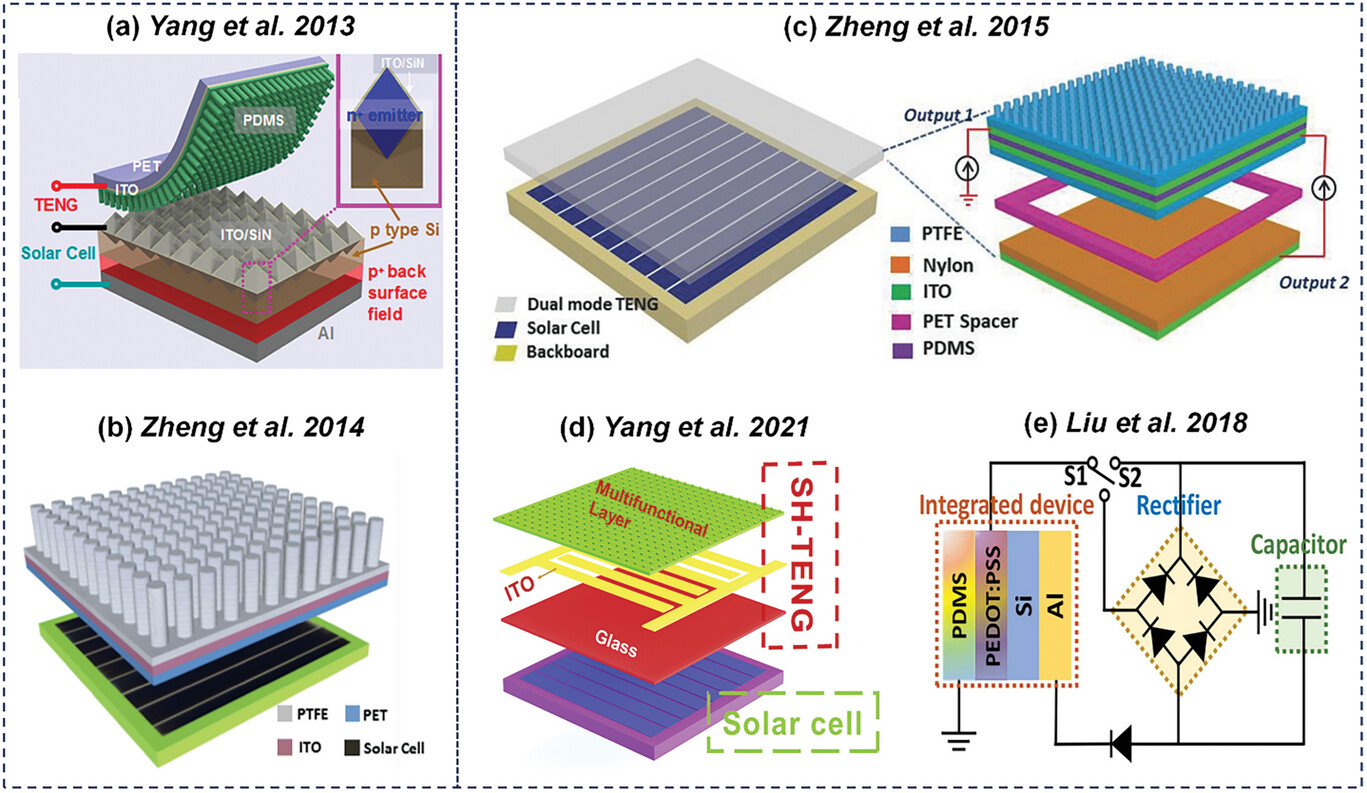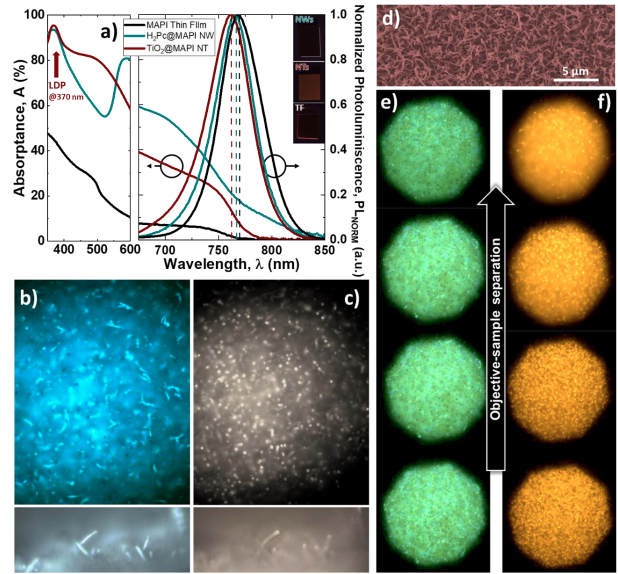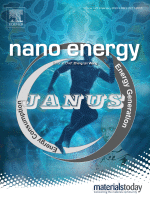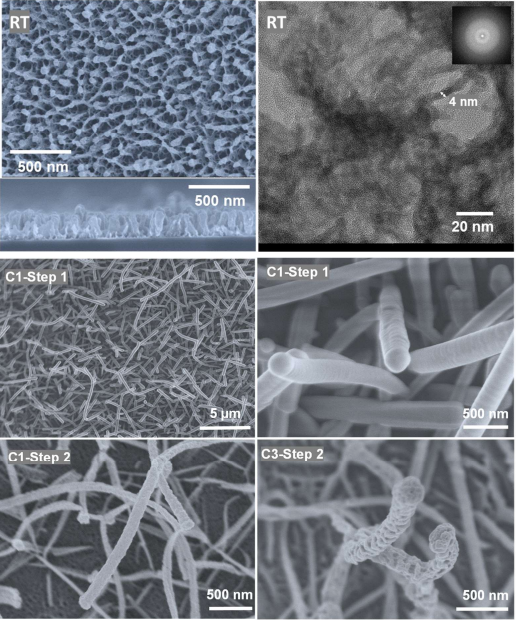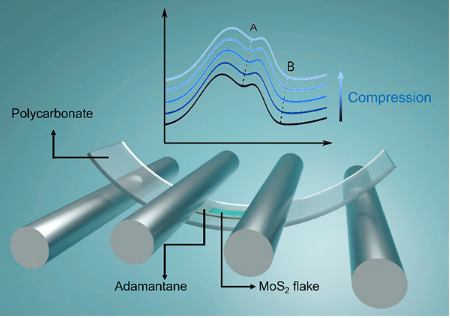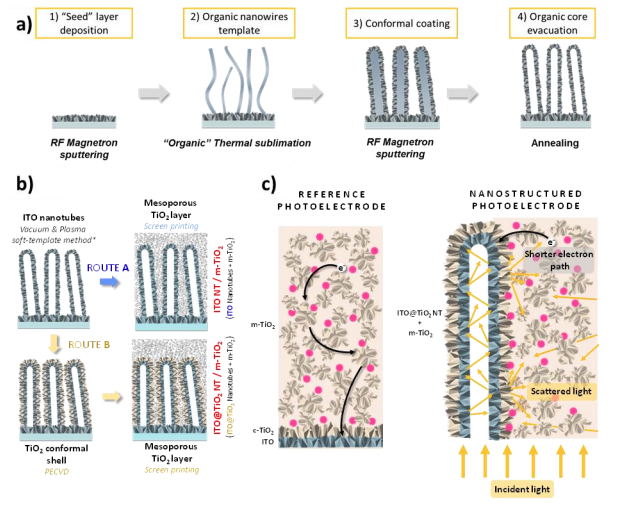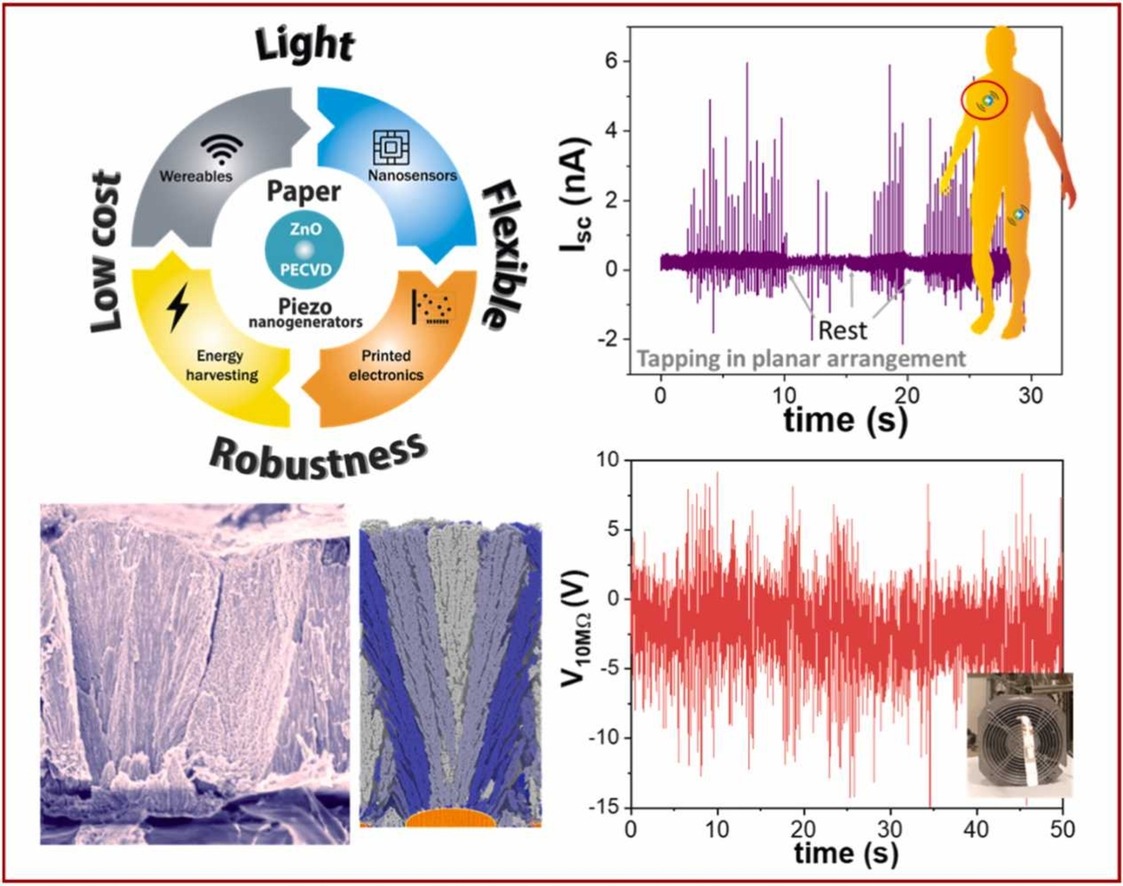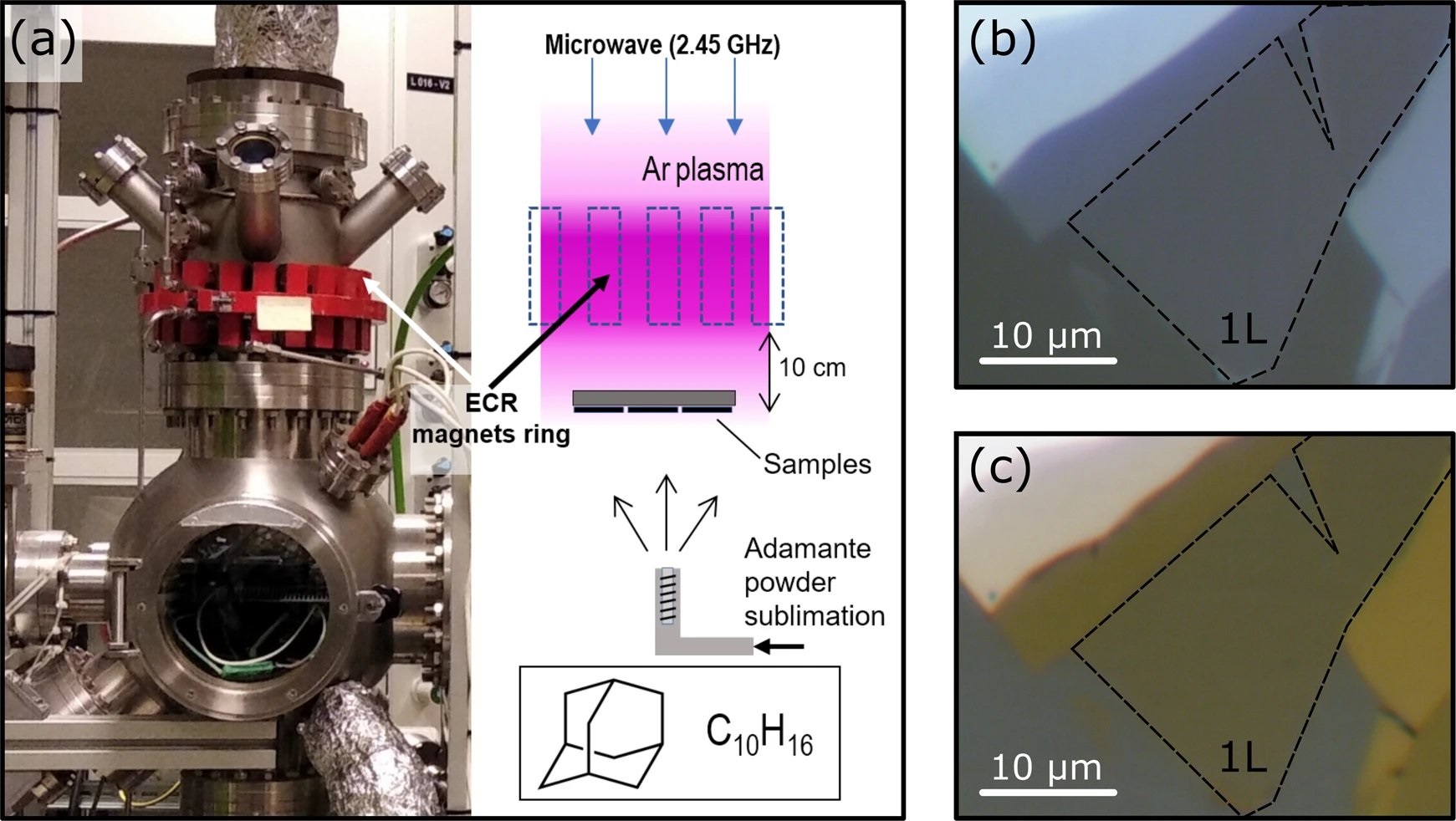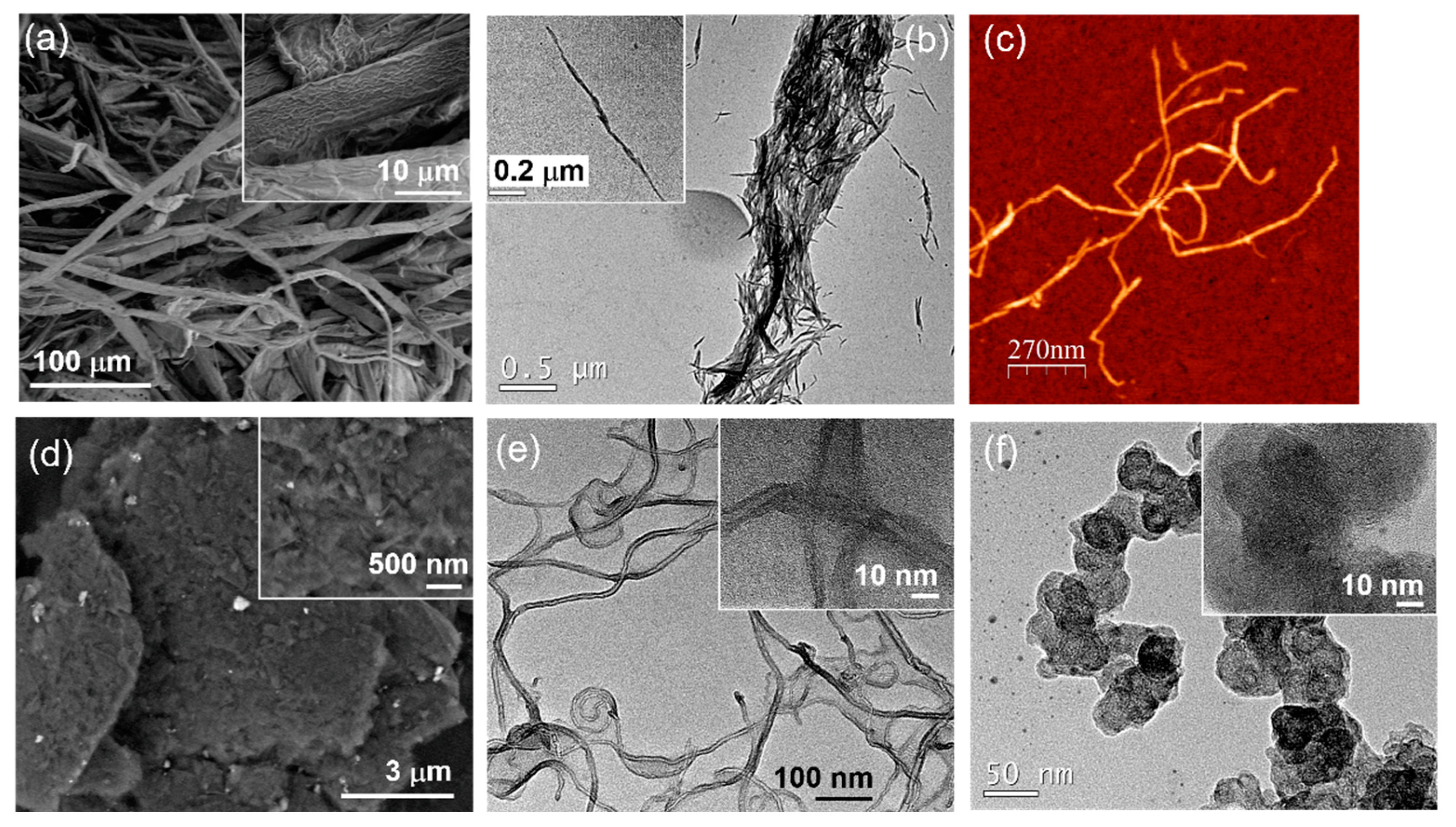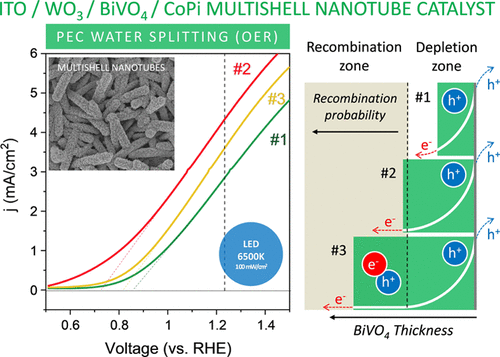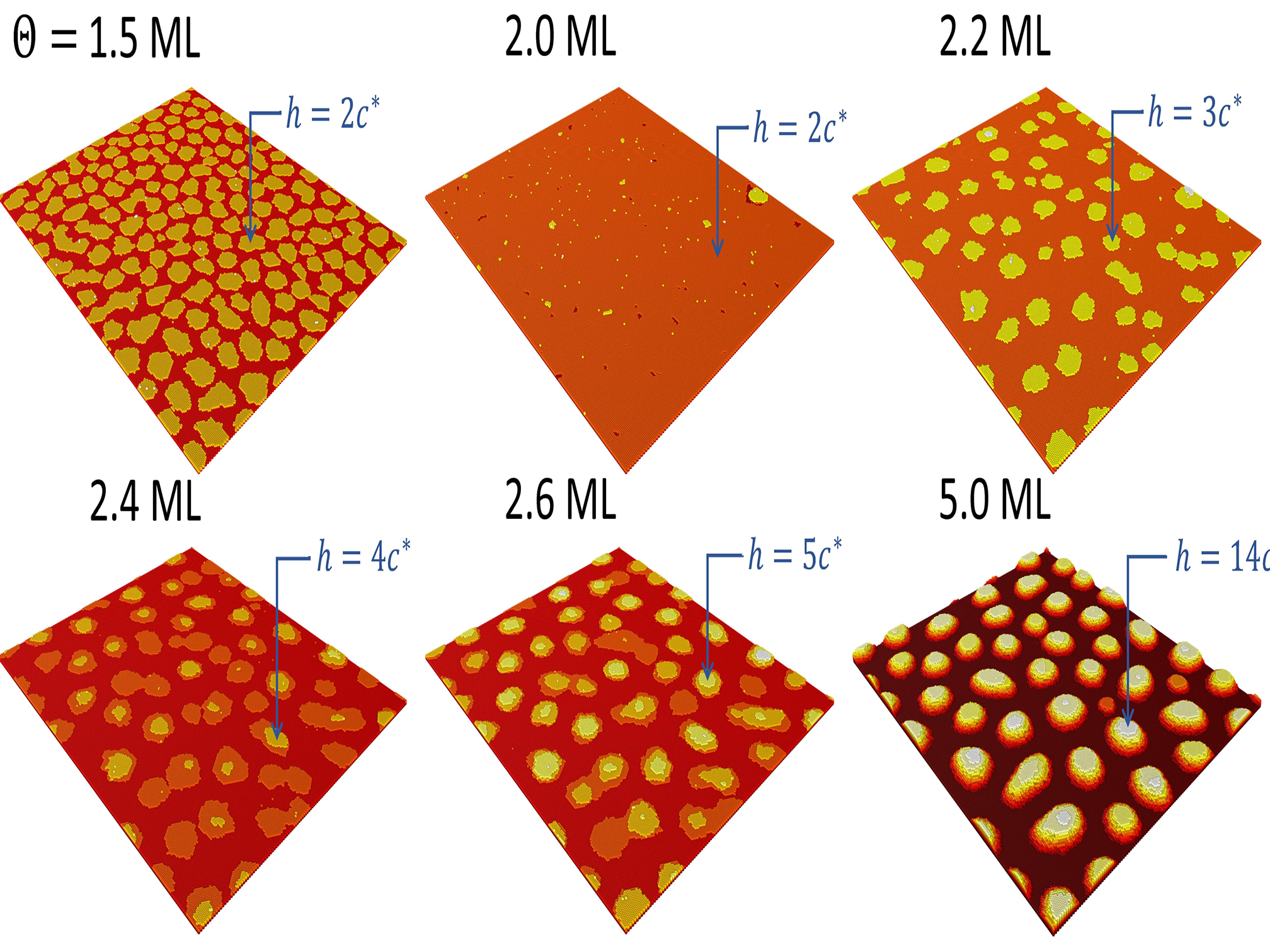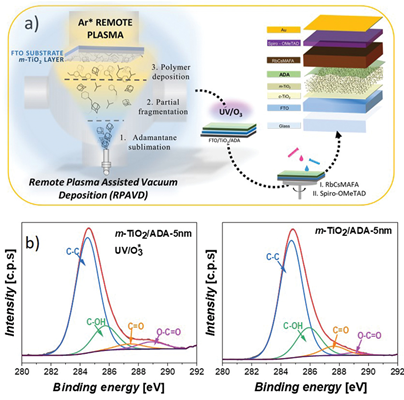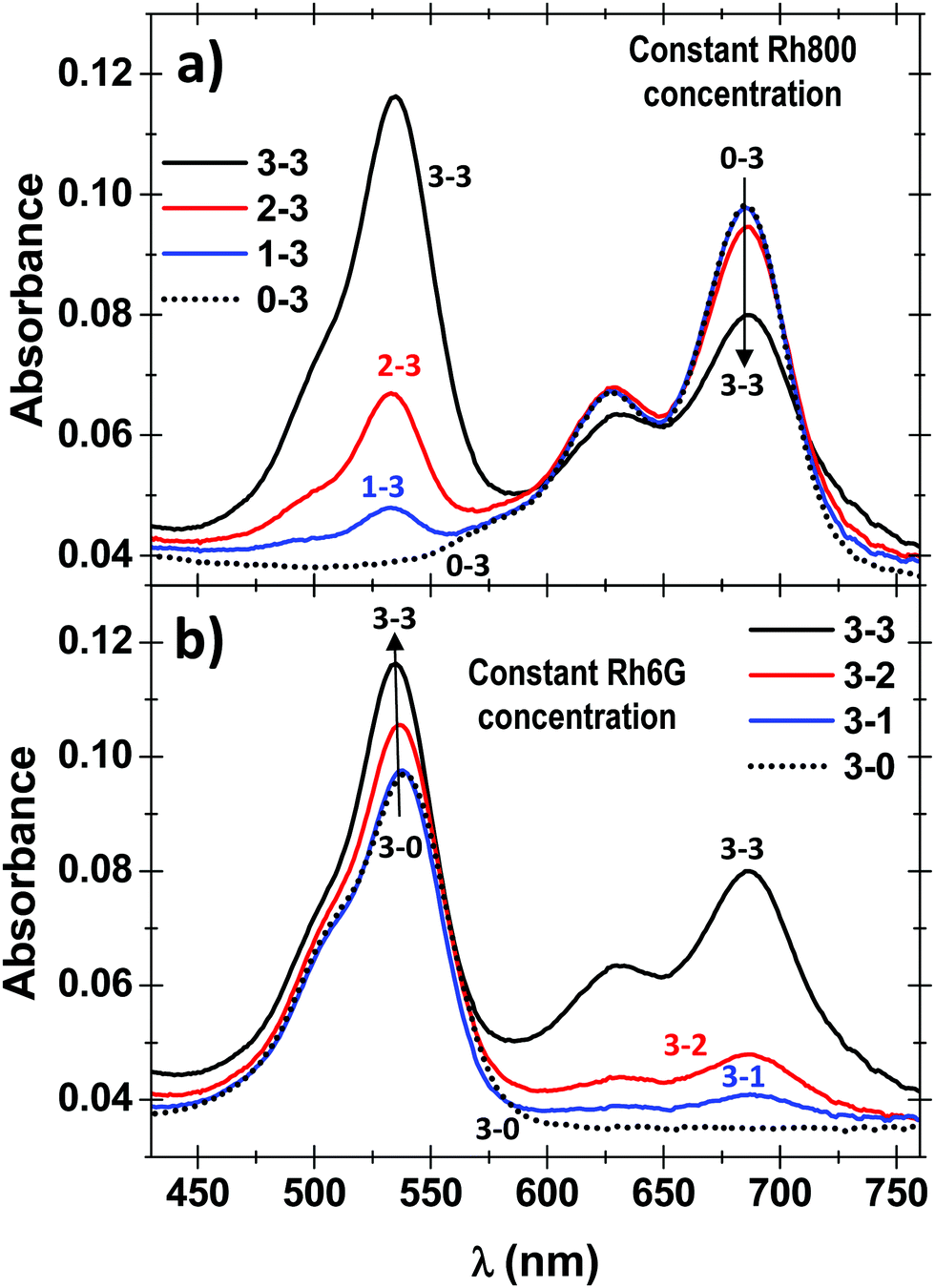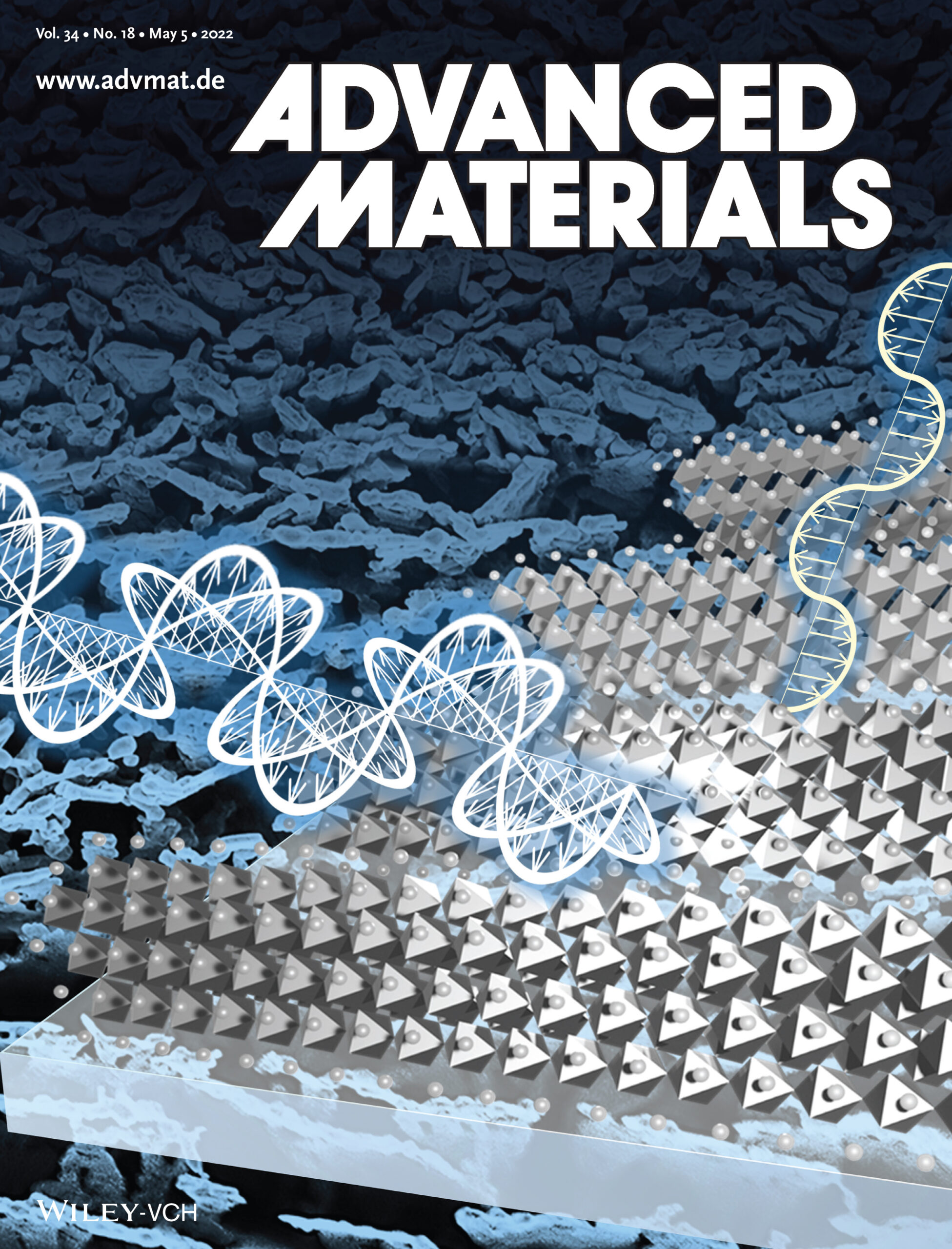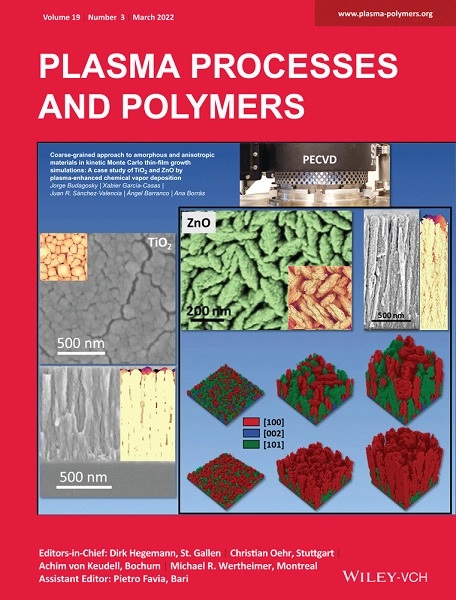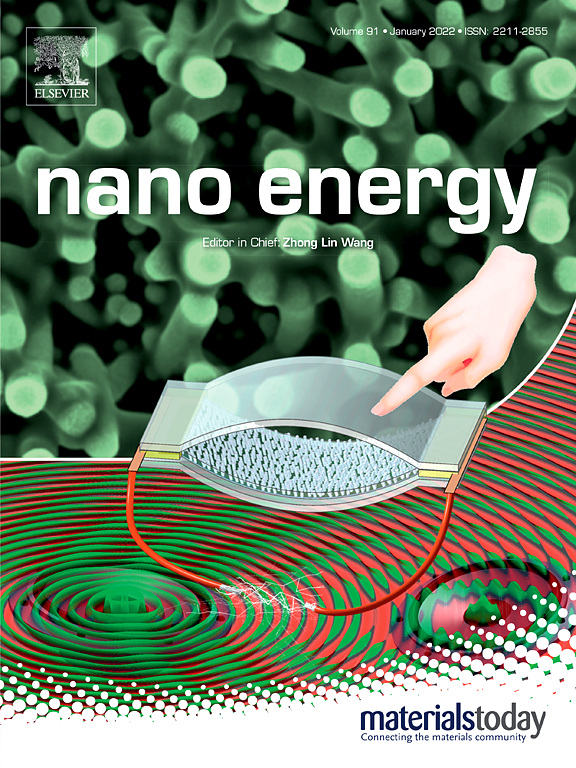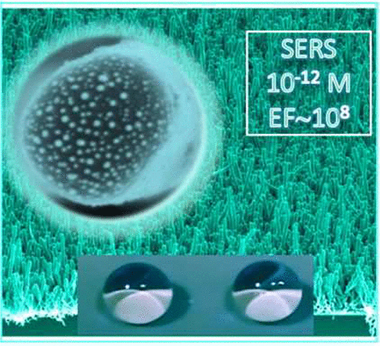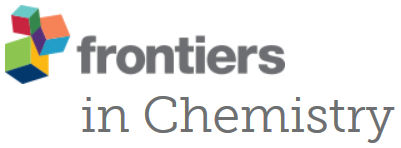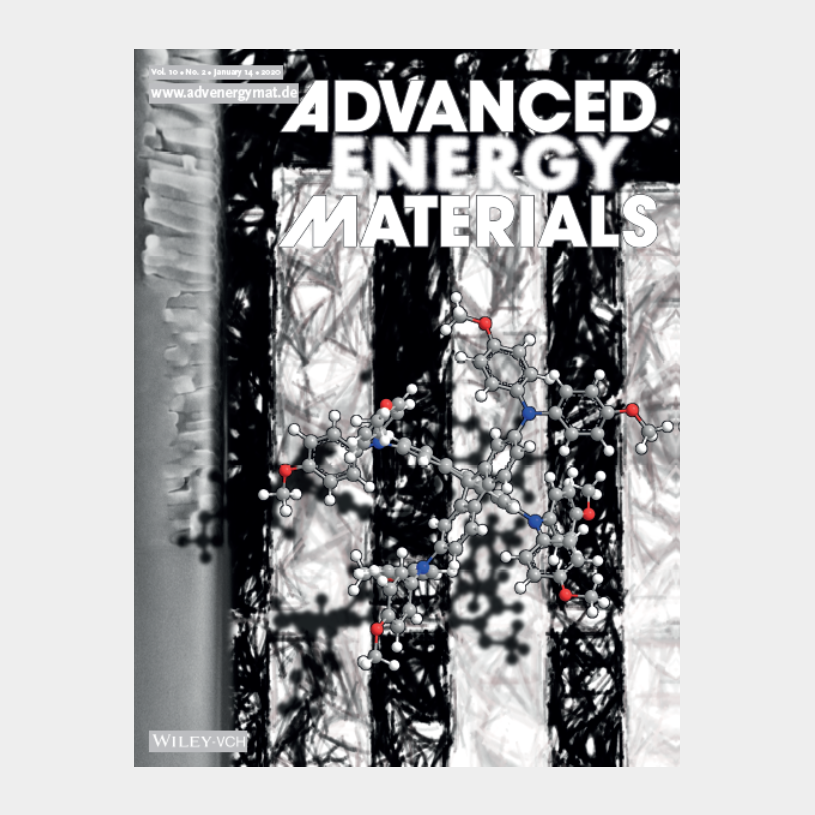2024
Triboelectric Pixels as building blocks for microscale and large area integration of drop energy harvesters
Ali Ghaffarinejad, Xabier Garcia-Casas, Fernando Nunez-Galvez, Jorge Budagosky, Vanda Godinho, Carmen Lopez-Santos, Juan Ramon Sanchez-Valencia, Angel Barranco, Ana Borras
arXiv:2405.02464 [physics.app-ph]
DOI: arXiv.2405.02464
The ultimate step towards the exploitation of water as a clean and renewable energy source addresses the energies stored in the low frequencies of liquid flows, which demands flexible solutions to adapt to multiple scenarios, from raindrops to waves, including water moving in pipelines and microdevices. Thus, harvesting low-frequency flows is a young concept compared to solar and wind powers, where triboelectric nanogenerators have been revealed as the most promising relevant actors. However, despite widespread attempts by researchers, the drop energy harvesters’ output power is still low, mainly because of the limitations in candidates endowed with ideal triboelectric and wetting properties and also the non-optimal and centimetre-scale device architecture that prevents the conversion of the complete kinetic energy of impinging drops. Herein, we disclose a microscale triboelectric nanogenerator that can harvest a high density of electrical power from drops through a single, submillisecond, long-lasting step. The mechanism relies on an instantaneous electrical capacitance variation owing to the high-speed contact of the drops with the electrodes’ active area. We discuss the role of the precharged effect of the triboelectric surface in the time characteristic of the conversion event. The capacitive and microscale structure of the device is endowed with a small form factor that allows for the production of densely packed arrays. The proposed architecture can be adjusted to different liquids and scales and is compatible with a variety of triboelectric surfaces, including flexible, transparent, and thin-film approaches.
Synergistic Integration of Nanogenerators and Solar Cells: Advanced Hybrid Structures and Applications
Sugato Hajra, Amanat Ali, Swati Panda, Heewoon Song, P. M. Rajaitha, Deepak Dubal, Ana Borras, Pichaya In-Na, Naratip Vittayakorn, Venkateswaran Vivekananthan, Hoe Joon Kim, Sivasubramani Divya, Tae Hwan Oh
Advanced Energy Materials, 2024, 2400025
The rapid growth of global energy consumption and the increasing demand for sustainable and renewable energy sources have urged vast research into harnessing energy from various sources. Among them, the most promising approaches are nanogenerators (NGs) and solar cells (SCs), which independently offer innovative solutions for energy harvesting. This review paper presents a comprehensive analysis of the integration of NGs and SCs, exploring advanced hybrid structures and their diverse applications. First, an overview of the principles and working mechanisms of NGs and SCs is provided for seamless hybrid integrations. Then, various design strategies are discussed, such as piezoelectric and triboelectric NGs with different types of SCs. Finally, a wide range of applications are explored that benefit from the synergistic integration of NGs and SCs, including self-powered electronics, wearable devices, environmental monitoring, and wireless sensor networks. The potential for these hybrid systems is highlighted to address real-world energy needs and contribute to developing sustainable and self-sufficient technologies. In conclusion, this review provides valuable insights into the state-of-the-art developments in NGs and SCs integration, shedding light on advanced hybrid structures and their diverse applications.
Highly stable photoluminescence in vacuum-processed halide perovskite core-shell 1D nanostructures
Javier Castillo-Seoane, Lidia Contreras-Bernal, T. Cristina Rojas, Juan P. Espinos, Andres-Felipe Castro-Mendez, Juan-P. Correa-Baena, Angel Barranco, Juan R. Sanchez-Valencia, Ana Borras
arXiv:2402.19269 [physics.app-ph]
DOI: 10.48550/arXiv.2402.19269
Hybrid organometal halide perovskites (HP) present exceptional optoelectronic properties, but their poor long-term stability is a major bottleneck for their commercialization. Herein, we present a solvent-free approach to growing single-crystal organic nanowires (ONW), nanoporous metal oxide scaffolds, and HP to form a core@multishell architecture. The synthetic procedure is carried out under mild vacuum conditions employing thermal evaporation for the metal-free phthalocyanine (H2Pc) nanowires, which will be the core, plasma-enhanced chemical vapor deposition (PECVD) for the TiO2 shell, and co-evaporation of lead iodide (PbI2) and methylammonium iodide (CH3NH3I / MAI) for the CH3NH3PbI3 (MAPbI3 / MAPI) perovskite shell. We present a detailed characterization of the nanostructures by (S)-TEM and XRD, revealing a different crystallization of the hybrid perovskite depending on the template: while the growth on H2Pc nanowires induces the typical tetragonal structure of the MAPI perovskite, a low-dimensional phase (LDP) was observed on the one-dimensional TiO2 nanotubes. Such a combination yields an unprecedentedly stable photoluminescence emission over 20 hours and over 300 hours after encapsulation in polymethyl methacrylate (PMMA) under different atmospheres including N2, air, and high moisture levels. In addition, the unique one-dimensional morphology of the system, together with the high refractive index HP, allows for a strong waveguiding effect along the nanowire length.
Towards Efficient Strain Engineering of 2D Materials: A Four-Points Bending Approach for Compressive Strain
Hao Li, Félix Carrascoso, Ana Borrás, Gloria P. Moreno, Francisco J. Aparicio, Ángel Barranco, Andrés Castellanos Gómez
Nano Res., Just Accepted Manuscript (Dec, 2023)
DOI: 10.1007/s12274-023-6402-7
Strain engineering, as a powerful strategy to tune the optical and electrical properties of 2D materials by deforming their crystal lattice, hasattracted significant interest in recent years. 2D materials can sustain ultra-high strains, even up to 10%, due to the lack of danglingbondsontheir surface, making them ideal brittle solids. This remarkable mechanical resilience, together with a strong strain-tunable bandstructure,endows 2D materials with a broad optical and electrical response upon strain. However, strain engineering based on 2Dmaterialsisrestricted by their nanoscale and strain quantification troubles. In this study, we have modified a homebuilt three-points bendingapparatustotransform it into a four-points bending apparatus that allows for the application of both compressive and tensile strains on 2Dmaterials. Thisapproach allows for the efficient and reproducible construction of a strain system and minimizes the buckling effect caused by thevanderWaals interaction by adamantane encapsulation strategy. Our results demonstrate the feasibility of introducing compressive strainon2Dmaterials and the potential for tuning their optical and physical properties through this approach.
Editorial: Triboelectric and piezoelectric advances in Europe and North America
Renyun Zhang, Wenzhuo Wu, Chris Bowen, Philippe Basset, Christian Falconi, Ana Borras, Stephanos Konstantinidis, Rainer Adelung, Joao Ventura
Nano Energy, Volume 120, February 2024, 109113
DOI:10.1016/j.nanoen.2023.109113
The Sixth International Conference on Nanogenerators and Piezotronics (NGPT2022) took place under the auspices of Mid Sweden University from June 20 to 23, 2022. Originally planned as an in-person gathering, the conference switched to an online format in response to the challenges posed by the COVID-19 pandemic. Despite this adaptation, NGPT2022 drew substantial engagement, featuring over 100 abstracts and welcoming more than 200 participants from 15 countries. This global representation underscored the conference’s status as a focal point for cutting-edge research in the realms of nanogenerators and piezotronics. The conference remains an inclusive platform, inviting contributions from diverse studies associated with these burgeoning fields. After the conference, discussions between NGPT2022 Chairman and Nano Energy Editor-in-Chief, Prof. Zhong Lin Wang, centered on the prospect of publishing a special issue, with a deliberate emphasis on contributions from European and North American research groups. The resultant collection comprises articles addressing pivotal themes in nanogenerators and piezotronics, including fundamental investigations into triboelectrification mechanisms at liquid-solid interfaces, as well as applications involving eco-friendly materials. Comprehensive reviews highlighting the latest advancements in these domains are also featured in this special issue. Our overarching aim is to catalyze the ongoing discourse and research momentum in nanogenerators and piezoelectronics, thereby amplifying the impact of our collective scientific strides. Through this initiative, we aspire to foster a deeper understanding of the science and tehcnology of nanogenerators and piezotronics and stimulate further innovation within the scientific community.
2023
Multidimensional nanoarchitectures for improved indoor light harvesting in dye-sensitized solar cells
Javier Castillo-Seoane, Lidia Contreras-Bernal, Antonio J. Riquelme, Samuel Fauvel, Yann Kervella, Jorge Gil-Rostra, Gabriel Lozano, Angel Barranco, Renaud Demadrille, Juan R. Sanchez-Valencia, Ana Borras
ArXiv:2312.16663 [physics.app-ph]
DOI: 10.48550/arXiv.2312.16663
Dye Sensitized Solar Cells (DSSCs) have recently regained attention for indoor light harvesting and powering wireless devices. Advantages such as cost-effectiveness, flexibility, wide angular response, and lightweight design have driven the fostering of the implementation of advanced photonic architectures, dedicated photosensitizers and compatibility with wearable carriers. However, to fully exploit their potential, crucial aspects require further attention, in particular the improvement of spectral compatibility and low-light harvesting mechanisms, as well as the development of efficient photoanodes through high-yield scalable methods. In this article, we propose the use of nanocomposite photoanodes integrating mesoporous TiO2 (m-TiO2) nanoparticles, ITO nanotubes (NTs) and TiO2 anatase shells (ITO@TiO2 NTs) prepared by step-by-step method relying on mild temperature conditions and avoiding toxic precursors. These photoanodes outperform previous attempts to implement low-dimensional ITO and ITO@TiO2 nanowires and nanotubes for outdoor light conversion, demonstrating an outstanding PCE under low artificial light intensity of 24 % for at 0.014 mWcm-2, a 166 % increase compared to the conventional architectures. Advanced microstructural, optical, and electrochemical characterizations have revealed that the strong scattering effect of the light in the visible range coupled with enhanced charge collection at low-intensity illumination are the essential mechanisms responsible for such enhanced energy conversion. Remarkably, our devices retain up to 90% of the normal incidence efficiency even under glancing illumination, while conventional reference devices show a drop down to 50%
Advanced Cellulose–Nanocarbon Composite Films for High-Performance Triboelectric and Piezoelectric Nanogenerators
Jaime González, Ali Ghaffarinejad, Maxim Ivanov, Paula Ferreira, Paula M Vilarinho, Ana Borrás, Harvey Amorín, Bernd Wicklein
Nanomaterials, Volumen 13, Número 7, Páginas 1206
DOI: 10.3390/nano13071206
Natural polymers such as cellulose have interesting tribo- and piezoelectric properties for paper-based energy harvesters, but their low performance in providing sufficient output power is still an impediment to a wider deployment for IoT and other low-power applications. In this study, different types of celluloses were combined with nanosized carbon fillers to investigate their effect on the enhancement of the electrical properties in the final nanogenerator devices. Cellulose pulp (CP), microcrystalline cellulose (MCC) and cellulose nanofibers (CNFs) were blended with carbon black (CB), carbon nanotubes (CNTs) and graphene nanoplatelets (GNPs). The microstructure of the nanocomposite films was characterized by scanning electron and probe microscopies, and the electrical properties were measured macroscopically and at the local scale by piezoresponse force microscopy. The highest generated output voltage in triboelectric mode was obtained from MCC films with CNTs and CB, while the highest piezoelectric voltage was produced in CNF-CNT films. The obtained electrical responses were discussed in relation to the material properties. Analysis of the microscopic response shows that pulp has a higher local piezoelectric d33 coefficient (145 pC/N) than CNF (14 pC/N), while the macroscopic response is greatly influenced by the excitation mode and the effective orientation of the crystals relative to the mechanical stress. The increased electricity produced from cellulose nanocomposites may lead to more efficient and biodegradable nanogenerators.
Paper-based ZnO self-powered sensors and nanogenerators by plasma technology
Xabier García-Casas, Francisco J. Aparicio, Jorge Budagosky, Ali Ghaffarinejad, Noel Orozco-Corrales, Kostya (Ken) Ostrikov, Juan R. Sánchez-Valencia, Ángel Barranco, Ana Borrás
Nano Energy Volume 114, September 2023, 108686
DOI: 10.1016/j.nanoen.2023.108686
Nanogenerators and self-powered nanosensors have shown the potential to power low-consumption electronics and human-machine interfaces, but their practical implementation requires reliable, environmentally friendly and scalable processes for manufacturing and processing. Furthermore, the emerging flexible and wearable electronics technology demands direct fabrication onto innovative substrates such as paper and plastics typically incompatible with high process temperatures. This article presents a plasma synthesis approach for the fabrication of piezoelectric nanogenerators (PENGs) and self-powered sensors on paper substrates. Polycrystalline ZnO nanocolumnar thin films are deposited by plasma-enhanced chemical vapour deposition on common paper supports using a microwave electron cyclotron resonance reactor working at room temperature yielding high growth rates and low structural and interfacial stresses. Applying Kinetic Monte Carlo simulation, we elucidate the basic shadowing mechanism behind the characteristic microstructure and porosity of the ZnO thin films, relating them to an enhanced piezoelectric response to periodic and random inputs. The piezoelectric devices are assembled by embedding the ZnO films in polymethylmethacrylate (PMMA) and using Au thin layers as electrodes in two different configurations, namely laterally and vertically contacted devices. We present the response of the laterally connected devices as a force sensor for low-frequency events with different answers to the applied force depending on the impedance circuit, i.e. load values range, a behaviour that is theoretically analyzed. The characterization of the vertical devices in cantilever-like mode reaches instantaneous power densities of 80 nW/cm2 with a mean power output of 20 nW/cm2. Besides, we analyze their actual-scenario performance by activation with a fan and handwriting. Overall, this work demonstrates the advantages of implementing plasma deposition for piezoelectric films to develop robust, flexible, stretchable, and enhanced-performance nanogenerators and self-powered piezoelectric sensors compatible with inexpensive and recyclable supports.
Improved strain engineering of 2D materials by adamantane plasma polymer encapsulation
Felix Carrascoso, Hao Li, Jose M. Obrero-Perez, Francisco J. Aparicio, Ana Borras, Joshua O. Island, Angel Barranco & Andres Castellanos-Gomez
npj 2D Materials and Applications volume 7, Article number: 24 (2023)
DOI: 10.1038/s41699-023-00393-1
Two-dimensional materials present exceptional crystal elasticity and provide an ideal platform to tune electrical and optical properties through the application of strain. Here we extend recent research on strain engineering in monolayer molybdenum disulfide using an adamantane plasma polymer pinning layer to achieve unprecedented crystal strains of 2.8%. Using micro-reflectance spectroscopy, we report maximum strain gauge factors of −99.5 meV/% and −63.5 meV/% for the A and B exciton of monolayer MoS2, respectively, with a 50 nm adamantane capping layer. These results are corroborated with photoluminescence and Raman measurements on the same samples. Taken together, our results indicate that adamantane polymer is an exceptional capping layer to transfer substrate-induced strain to a 2D layer and achieve higher levels of crystal strain.
Photoelectrochemical Water Splitting with ITO/WO3/BiVO4/CoPi Multishell Nanotubes Enabled by a Vacuum and Plasma Soft-Template Synthesis
Jorge Gil-Rostra, Javier Castillo-Seoane, Qian Guo, Ana Belén Jorge Sobrido, Agustín R. González-Elipe, and Ana Borrás
CS Appl. Mater. Interfaces 2023, 15, 7, 9250–9262 2022,14 (17), 3052
Nanoscale,13 (32), 13882-13895
A common approach for the photoelectrochemical (PEC) splitting of water relies on the application of WO3 porous electrodes sensitized with BiVO4 acting as a visible photoanode semiconductor. In this work, we propose a new architecture of photoelectrodes consisting of supported multishell nanotubes (NTs) fabricated by a soft-template approach. These NTs are formed by a concentric layered structure of indium tin oxide (ITO), WO3, and BiVO4, together with a final thin layer of cobalt phosphate (CoPi) co-catalyst. The photoelectrode manufacturing procedure is easily implementable at a large scale and successively combines the thermal evaporation of single crystalline organic nanowires (ONWs), the magnetron sputtering deposition of ITO and WO3, and the solution dripping and electrochemical deposition of, respectively, BiVO4 and CoPi, plus the annealing in air under mild conditions. The obtained NT electrodes depict a large electrochemically active surface and outperform the efficiency of equivalent planar-layered electrodes by more than one order of magnitude. A thorough electrochemical analysis of the electrodes illuminated with blue and solar lights demonstrates that the characteristics of the WO3/BiVO4 Schottky barrier heterojunction control the NT electrode efficiency, which depended on the BiVO4 outer layer thickness and the incorporation of the CoPi electrocatalyst. These results support the high potential of the proposed soft-template methodology for the large-area fabrication of highly efficient multishell ITO/WO3/BiVO4/CoPi NT electrodes for the PEC splitting of water..
2022
Multiscale Kinetic Monte Carlo Simulation of Self-Organized Growth of GaN/AlN Quantum Dots
Jorge A. Budagosky and Alberto García-Cristobal
Nanomaterials 2022,14 (17), 3052
DOI: 10.3390/nano12173052
A three-dimensional kinetic Monte Carlo methodology is developed to study the strained epitaxial growth of wurtzite GaN/AlN quantum dots. It describes the kinetics of effective GaN adatoms on an hexagonal lattice. The elastic strain energy is evaluated by a purposely devised procedure: first, we take advantage of the fact that the deformation in a lattice-mismatched heterostructure is equivalent to that obtained by assuming that one of the regions of the system is subjected to a properly chosen uniform stress (Eshelby inclusion concept), and then the strain is obtained by applying the Green’s function method. The standard Monte Carlo method has been modified to implement a multiscale algorithm that allows the isolated adatoms to perform long diffusion jumps. With these state-of-the art modifications, it is possible to perform efficiently simulations over large areas and long elapsed times. We have taylored the model to the conditions of molecular beam epitaxy under N-rich conditions. The corresponding simulations reproduce the different stages of the Stranski–Krastanov transition, showing quantitative agreement with the experimental findings concerning the critical deposition, and island size and density. The influence of growth parameters, such as the relative fluxes of Ga and N and the substrate temperature, is also studied and found to be consistent with the experimental observations. In addition, the growth of stacked layers of quantum dots is also simulated and the conditions for their vertical alignment and homogenization are illustrated. In summary, the developed methodology allows one to reproduce the main features of the self-organized quantum dot growth and to understand the microscopic mechanisms at play.
Rhodamine 6G and 800 intermolecular heteroaggregates embedded in PMMA for near-infrared wavelength shifting
Javier Castillo-Seoane, Lola González-García, Jose Manuel Obrero-Pérez, Francisco Javier Aparicio, Ana Isabel Borrás, Agustín R. González Elipe, Ángel Barranco y Juan Ramon Sanchez-Valencia
Journal of Materials Chemistry C, 2022, 10, 7119-7131
DOI: 10.1039/D1TC06167D
The opto-electronic properties of small-molecules and functional dyes usually differ when incorporated into solid matrices with respect to their isolated form due to an aggregation phenomenon that alters their optical and fluorescent properties. These spectroscopic modifications are studied in the framework of the exciton theory of aggregates, which has been extensively applied in the literature for the study of molecular aggregates of the same type of molecules (homoaggregation). Despite the demonstrated potential of the control of the heteroaggregation process (aggregation of different types of molecules), most of the reported works are devoted to intramolecular aggregates, complex molecules formed by several chromophores attached by organic linkers. The intramolecular aggregates are specifically designed to hold a certain molecular structure that, on the basis of the exciton theory, modifies their optical and fluorescent properties with respect to the isolated chromophores that form the molecule. The present article describes in detail the incorporation of Rhodamine 6G (Rh6G) and 800 (Rh800) into polymeric matrices of poly-(methyl methacrylate), PMMA. The simultaneous incorporation of both dyes results in an enhanced fluorescent emission in the near-infrared (NIR), originating from the formation of ground-state Rh6G–Rh800 intermolecular heteroaggregates. The systematic control of the concentration of both rhodamines provides a model system for the elucidation of the heteroaggregate formation. The efficient energy transfer between Rh6G and Rh800 molecules can be used as wavelength shifters to convert effectively the light from visible to NIR, a very convenient wavelength range for many practical applications which make use of inexpensive commercial detectors and systems.
Ultrathin Plasma Polymer Passivation of Perovskite Solar Cells for Improved Stability and Reproducibility
Jose Manuel Obrero-Perez, Lidia Contreras-Bernal, Fernando Nuñez-Galvez, Javier Castillo-Seoane, Karen Valadez-Villalobos, Francisco Javier Aparicio, Juan A. Anta, Ana Borrás, Juan Ramon Sanchez-Valencia, Ángel Barranco
Advanced Energy Materials 2022 (12), 2200812
Despite the youthfulness of hybrid halide perovskite solar cells, their efficiencies are currently comparable to commercial silicon and have surpassed quantum-dots solar cells. Yet, the scalability of these devices is a challenge due to their low reproducibility and stability under environmental conditions. However, the techniques reported to date to tackle such issues recurrently involve the use of solvent methods that would further complicate their transfer to industry. Herein a reliable alternative relaying in the implementation of an ultrathin plasma polymer as a passivation interface between the electron transport layer and the hybrid perovskite layer is presented. Such a nanoengineered interface provides solar devices with increased long-term stability under ambient conditions. Thus, without involving any additional encapsulation step, the cells retain more than 80% of their efficiency after being exposed to the ambient atmosphere for more than 1000 h. Moreover, this plasma polymer passivation strategy significantly improves the coverage of the mesoporous scaffold by the perovskite layer, providing the solar cells with enhanced performance, with a champion efficiency of 19.2%, a remarkable value for Li-free standard mesoporous n-i-p architectures, as well as significantly improved reproducibility.
Highly Anisotropic Organometal Halide Perovskite Nanowalls Grown by Glancing-Angle Deposition
Javier Castillo-Seoane, Lidia Contreras-Bernal, Jose Manuel Obrero-Perez, Xabier García-Casas, Francisco Lorenzo-Lázaro, Francisco Javier Aparicio, Carmen Lopez-Santos, Teresa Cristina Rojas, Juan Antonio Anta, Ana Borrás, Ángel Barranco, Juan Ramon Sanchez-Valencia
Advanced Materials 2022 (18), 2107739
Polarizers are ubiquitous components in current optoelectronic devices as displays or photographic cameras. Yet, control over light polarization is an unsolved challenge, since the main drawback of the existing display technologies is the significant optical losses. In such a context, organometal halide perovskites (OMHP) can play a decisive role given their flexible synthesis with tunable optical properties such as bandgap and photoluminescence, and excellent light emission with a low non-radiative recombination rate. Therefore, along with their outstanding electrical properties have elevated hybrid perovskites as the material of choice in photovoltaics and optoelectronics. Among the different OMHP nanostructures, nanowires and nanorods have lately arisen as key players in the control of light polarization for lighting or detector applications. Herein, the fabrication of highly aligned and anisotropic methylammonium lead iodide perovskite nanowalls by glancing-angle deposition, which is compatible with most substrates, is presented. Their high alignment degree provides the samples with anisotropic optical properties such as light absorption and photoluminescence. Furthermore, their implementation in photovoltaic devices provides them with a polarization-sensitive response. This facile vacuum-based approach embodies a milestone in the development of last-generation polarization-sensitive perovskite-based optoelectronic devices such as lighting appliances or self-powered photodetectors.
Coarse-grained approach to amorphous and anisotropic materials in kinetic Monte Carlo thin-film growth simulations: A case study of TiO2 and ZnO by plasma-enhanced chemical vapor deposition
Jorge Budagosky, Xabier García-Casas, Juan R. Sánchez-Valencia, Ángel Barranco, Ana Borrás
Plasma Processes and Polymers 19 (2022) 2270008
The growth of TiO2and ZnO thin films is studied by means of coarse-grained kinetic Monte Carlo simulations under conditions typically encountered in plasma-enhanced chemical vapor deposition experiments. The basis of our approach is known to work well to simulate the growth of amorphous materials using cubic grids and is extended here to reproduce not only the morphological characteristics and scaling properties of amorphous TiO2 but also the growth of polycrystalline ZnO with a good approximation, including the evolution of the film texture during growth and its dependence on experimental conditions. The results of the simulations have been compared with available experimental data obtained by X-ray diffraction, analysis of the texture coefficients, atomic force microscopy, and scanning electron microscopy.
Plasma engineering of microstructured piezo – Triboelectric hybrid nanogenerators for wide bandwidth vibration energy harvesting
Xabier García-Casas, Ali Ghaffarinejad, Francisco J.Aparicio, Javier Castillo-Seoane, Carmen López-Santos, Juan P. Espinós, José Cotrino, Juan Ramón Sánchez-Valencia, ÁngelBarranco and Ana Borrás
Nano Energy 91 (2022), 106673
DOI: 10.1016/j.nanoen.2021.106673
We introduce herein the advanced application of low-pressure plasma procedures for the development of piezo and triboelectric mode I hybrid nanogenerators. Thus, plasma-assisted assisted deposition and functionalization methods are presented as key enabling technologies for the nanoscale design of ZnO polycrystalline shells, the formation of conducting metallic cores in core@shell nanowires, and for the solventless surface modification of polymeric coatings and matrixes. We show how the perfluorinated chains grafting of polydimethylsiloxane (PDMS) provides a reliable approach to increase the hydrophobicity and surface charges at the same time that keeping the PDMS mechanical properties. In this way, we produce efficient Ag/ZnO convoluted piezoelectric nanogenerators supported on flexible substrates and embedded in PDMS compatible with a contact–separation triboelectric architecture. Factors like crystalline texture, ZnO thickness, nanowires aspect ratio, and surface chemical modification of the PDMS are explored to optimize the power output of the nanogenerators aimed for harvesting from low-frequency vibrations. Just by manual triggering, the hybrid device can charge a capacitor to switch on an array of color LEDs. Outstandingly, this simple three-layer architecture allows for harvesting vibration energy in a wide bandwidth, thus, we show the performance characteristics for frequencies between 1 Hz and 50 Hz and demonstrate the successful activation of the system up to ca. 800 Hz.
2021
One-reactor vacuum and plasma synthesis of transparent conducting oxide nanotubes and nanotrees: from single wire conductivity to ultra-broadband perfect absorbers in the NIR
Javier Castillo-Seoane, Jorge Gil-Rostra, Víctor López-Flores, Gabriel Lozano, F. Javier Ferrer, Juan P. Espinós, Kostya (Ken) Ostrikov, Francisco Yubero, Agustín R. González-Elipe, Ángel Barranco, Juan R. Sánchez-Valencia and Ana Isabel Borrás
Nanoscale,13 (32), 13882-13895
DOI: 10.1039/D1NR01937F
The eventual exploitation of one-dimensional nanomaterials needs the development of scalable, high yield, homogeneous and environmentally friendly methods capable of meeting the requirements for fabrication of functional nanomaterials with properties on demand. In this article, we demonstrate a vacuum and plasma one-reactor approach for the synthesis of fundamental common elements in solar energy and optoelectronics, i.e. the transparent conducting electrode but in the form of nanotube and nanotree architectures. Although the process is generic and can be used for a variety of TCOs and wide-bandgap semiconductors, we focus herein on indium doped tin oxide (ITO) as the most previously researched in previous applications. This protocol combines widely applied deposition techniques such as thermal evaporation for the formation of organic nanowires serving as 1D and 3D soft templates, deposition of polycrystalline layers by magnetron sputtering, and removal of the templates by simply annealing under mild vacuum conditions. The process variables are tuned to control the stoichiometry, morphology, and alignment of the ITO nanotubes and nanotrees. Four-probe characterization reveals the improved lateral connectivity of the ITO nanotrees and applied on individual nanotubes shows resistivities as low as 3.5 ± 0.9 × 10–4 Ω cm, a value comparable to that of single-crystalline counterparts. The assessment of diffuse reflectance and transmittance in the UV-Vis range confirms the viability of the supported ITO nanotubes as random optical media working as strong scattering layers. Their further ability to form ITO nanotrees opens a path for practical applications as ultra-broadband absorbers in the NIR. The demonstrated low resistivity and optical properties of these ITO nanostructures open a way for their use in LEDs, IR shields, energy harvesting, nanosensors, and photoelectrochemical applications.
Plasma-Assisted Deposition of TiO2 3D Nanomembranes: Selective Wetting, Superomniphobicity, and Self-Cleaning
Laura Montes, Jose M. Román, Xabier García-Casas, Javier Castillo-Seoane, Juan Ramon Sanchez-Valencia, Ángel Barranco, Carmen López-Santos and Ana Borrás
Advanced Materials Interface8 (21), 2100767
Fabrication of tunable wetting surfaces is sought for the last years given its importance on energy, biomaterials and antimicrobials, water purification, microfluidics, and smart surfaces. Liquid management on surfaces mainly depends on the control at the micro- and nanoscale of both roughness and chemical composition. Herein, the combination of a soft-template method and plasma-enhanced chemical vapor deposition is presented for the synthesis of TiO2 nanofibers on porous substrates such as cellulose and stainless-steel membranes. The protocol, carried out under mild conditions, produces 3D nanomembranes with superhydrophobicity and oleophilicity that are tested as microliter water/oil filters. Photoactivation of TiO2 by UV illumination provides a straightforward approach for wetting tunability that converts the surface into amphiphilic. A final chemical modification of the TiO2 nanofibers by embedding them in an elastomeric polymeric shell and by fluorine-based grafting opens the path toward the formation of superomniphobic and self-cleaning surfaces with long-lasting lifetimes. Thus, a reliable procedure is demonstrated for the fabrication of TiO2 nanofibers, which allows the modification of porous supports and provides an innovative route for the development of 3D nanomembranes with under design wetting. This protocol is extendable to alternative metal oxides, metals, and core@shell nanoarchitectures with potential multifunctionalities.
2020
Plasma-Enabled Amorphous TiO2 Nanotubes as Hydrophobic Support for Molecular Sensing by SERS
Nicolas Filippin, Javier Castillo-Seoane, M. Carmen López-Santos, Cristina T. Rojas, Kostya Ostrikov, Angel Barranco, Juan R. Sánchez-Valencia, and Ana Borrás
ACS Applied Materials & Interfaces 2020 12 (45), 50721-50733
DOI: 10.1021/acsami.0c14087
Supported porous nanostructures developed by plasma processing of metal phthalocyanines and porphyrins
Obrero, J.M., Filippin, A.N., Alcaire, M., Sanchez-Valencia, J.R. , Jacob, M., Matei, C., Aparicio, F.J., Macias-Montero, M., Rojas, T.C., Espinos, J.P., Saghi, Z., Barranco, A., Borras, A.
Frontiers in Chemistry Accepted
DOI: 10.3389/fchem.2020.00520
Enhanced Stability of Perovskite Solar Cells Incorporating Dopant-Free Crystalline Spiro-OMeTAD Layers by Vacuum Sublimation
Barranco, A., Lopez-Santos, M.C., Idigoras, J., Aparicio, F.J., Obrero-Perez, J., Lopez-Flores, V., Contreras-Bernal, L., Rico, V., Ferrer, J., Espinos, J.P., Borras, A., Anta, J.A., Sanchez-Valencia, J.R.
Advanced Energy Materials, 10 (2020) 1901524
DOI: 10.1002/aenm.201901524
2019
3D Organic Nanofabrics: Plasma-Assisted Synthesis and Antifreezing Behavior of Superhydrophobic and Lubricant-Infused Slippery Surfaces
Alcaire, M., Lopez-Santos, C., Aparicio, F.J., Sanchez-Valencia, J.R., Obrero, J.M., Saghi, Z., Rico, V.J., De La Fuente, G., Gonzalez-Elipe, A.R., Barranco, A., Borras, A.
Langmuir, 35 (2019) 16876-16885
DOI: 10.1021/acs.langmuir.9b03116
Hydrophobicity, Freezing Delay, and Morphology of Laser-Treated Aluminum Surfaces
Rico, V.J., López-Santos, C., Villagrá, M., Espinós, J.P., De La Fuente, G.F., Angurel, L.A., Borrás, A., González-Elipe, A.R.
Langmuir, 35 (2019) 6483-6491
DOI: 10.1021/acs.langmuir.9b00457
Hydrophobic and icephobic behaviour of polyurethane-based nanocomposite coatings
Przybyszewski, B., Boczkowska, A., Kozera, R., Mora, J., Garcia, P., Aguero, A., Borras, A.
Coatings, 9 (2019) 811
DOI: 10.3390/coatings9120811
3D core-multishell piezoelectric nanogenerators
Filippin, A.N., Sanchez-Valencia, J.R., Garcia-Casas, X., Lopez-Flores, V., Macias-Montero, M., Frutos, F., Barranco, A., Borras, A.
Nano Energy, 58 (2019) 476-483
DOI: 10.1016/j.nanoen.2019.01.047
Multifunctional antimicrobial chlorhexidine polymers by remote plasma assisted vacuum deposition
Mora-Boza, A., Aparicio, F.J., Alcaire, M., López-Santos, C., Espinós, J.P., Torres-Lagares, D., Borrás, A., Barranco, A.
Frontiers of Chemical Science and Engineering, 13 (2019) 330-339
DOI: 10.1007/s11705-019-1803-6
Plasma Enabled Conformal and Damage Free Encapsulation of Fragile Molecular Matter: from Surface-Supported to On-Device Nanostructures
Alcaire, M., Aparicio, F.J., Obrero, J., López-Santos, C., Garcia-Garcia, F.J., Sánchez-Valencia, J.R., Frutos, F., Ostrikov, K., Borrás, A., Barranco, A.
Advanced Functional Materials, 29 (2019) 1903535
DOI: 10.1002/adfm.201903535
2018
Enhancing Moisture and Water Resistance in Perovskite Solar Cells by Encapsulation with Ultrathin Plasma Polymers
Idígoras, J., Aparicio, F.J., Contreras-Bernal, L., Ramos-Terrón, S., Alcaire, M., Sánchez-Valencia, J.R., Borras, A., Barranco, Á., Anta, J.A.
ACS Applied Materials and Interfaces, 10 (2018) 11587-11594
DOI: 10.1021/acsami.7b17824
The Role of Surface Recombination on the Performance of Perovskite Solar Cells: Effect of Morphology and Crystalline Phase of TiO2 Contact
Idígoras, J., Contreras-Bernal, L., Cave, J.M., Courtier, N.E., Barranco, A., Borras, A., Sánchez-Valencia, J.R., Anta, J.A., Walker, A.B.
Advanced Materials Interfaces, 5 (2018) 1801076
DOI: 10.1002/admi.201801076
